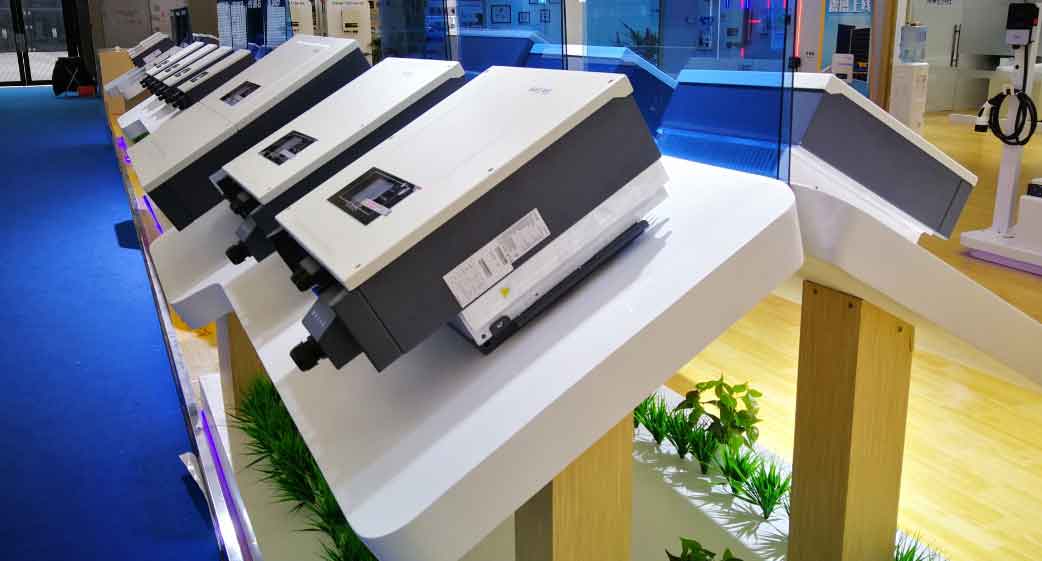Introduction
The integration of renewable energy sources into power systems has accelerated the development of microgrids, where energy storage inverter play a pivotal role in balancing power supply and demand. Energy storage inverter must operate in both grid-connected and islanded modes while maintaining voltage/frequency stability, precise power control, and seamless mode transitions. Traditional droop control methods face challenges such as frequency deviations, reactive power inaccuracies due to line impedance, and abrupt transitions during unplanned islanding. This paper proposes an improved self-recovery droop control (SRDC) strategy to address these limitations, enabling multi-dimensional optimization for energy storage inverter.
System Model and Power Transmission
1. Energy Storage Inverter Architecture
The energy storage inverter system comprises a DC-link capacitor, LC filters, static transfer switches (STS), and local/grid loads. The inverter interfaces with the grid through a point of common coupling (PCC), where voltage and frequency regulation are critical. The power flow equations for grid-connected and islanded modes are derived as:
Islanded Mode Power Flow: [ P{\text{load}} = \frac{U_o U{\text{PCC}} \sin(\theta_o – \theta{\text{PCC}})}{Z}, \quad Q{\text{load}} = \frac{U_o (U_o – U_{\text{PCC}})}{Z} ] Grid-Connected Mode Power Flow: [ P_g \propto \Delta \theta_L, \quad Q_g \propto \Delta U_o ] where ( \Delta \theta_L ) and ( \Delta U_o ) represent phase and voltage deviations between the inverter and grid.
2. Operational Modes and Challenges
- Islanded Mode: Requires frequency/voltage stability and accurate power sharing.
- Grid-Connected Mode: Demands precise active/reactive power control and smooth transitions during grid faults.
Improved Self-Recovery Droop Control (SRDC)
1. Core Enhancements
The proposed SRDC integrates two key innovations:
- Deviation Proportional Feedforward (DPF): Enhances transient response during load disturbances.
- Additional Grid-Power Control Loop: Enables precise grid power regulation and seamless islanding transitions.
2. Mathematical Formulation
Frequency Recovery Mechanism: [ \omega^* = \omega{\text{ref}} – m_P (P{\text{load}} – P{\text{res}}) + K(s) \cdot \frac{d}{dt} (\omega{\text{ref}} – \omega) ] Voltage Recovery Mechanism: [ \dot{U}^* = \dot{U}{\text{ref}} – n_Q (Q{\text{load}} – Q{\text{res}}) + K(s) \cdot \frac{d}{dt} (U{\text{ref}} – U) ] where ( K(s) ) is the feedforward coefficient, ( m_P ) and ( n_Q ) are droop coefficients, and ( P{\text{res}}/Q{\text{res}} ) are restoration terms.
3. Grid-Power Control Loop
The additional control loop ensures grid power follows references ( P{g,\text{ref}} ) and ( Q{g,\text{ref}} ): [ \Delta \omega_g = K{\omega} \int (P{g,\text{ref}} – P_g) dt + m{P2} (P{g,\text{ref}} – P_g) ] [ \Delta U_g = K{U} \int (Q{g,\text{ref}} – Q_g) dt + n{Q2} (Q{g,\text{ref}} – Q_g) ]
4. Key Parameters and Stability
Parameter Design Guidelines:
- ( K(s) \in [0, 1) ) to avoid overshoot while improving dynamics.
- Limiter thresholds for ( \Delta \omega_g ) and ( \Delta U_g ) ensure compliance with grid standards (e.g., ±0.5 Hz, ±10% voltage).
Simulation and Experimental Validation
1. Islanded Mode Performance
Frequency Recovery:
| Scenario | Traditional SRDC | Improved SRDC (( K(s)=0.6 )) |
|---|---|---|
| Frequency Overshoot | ±0.3 rad/s | ±0.2 rad/s |
| Settling Time | 0.5 s | 0.3 s |
Voltage Regulation: [ \Delta U_{\text{max}} \text{ (Improved SRDC)} = 10 \, \text{V vs. } 20 \, \text{V (Traditional)} ]
2. Grid-Connected Mode Performance
Active/Reactive Power Tracking:
- Step Response: 98% accuracy in ( P_g ) and ( Q_g ) under 15 kW load disturbance.
- Grid Voltage Perturbation: <2% deviation in ( P_g ) during 50 Hz → 50.01 Hz grid frequency shift.
3. Unplanned Islanding Transition
During grid faults, the limiter-based control ensures smooth transitions: [ \omega_o \in [49.5 \, \text{Hz}, 50.2 \, \text{Hz}], \quad U_o \in [0.85 U{\text{ref}}, 1.1 U{\text{ref}}] ]
Hardware-in-the-Loop (HIL) Results
Experiments on a 20 kW energy storage inverter validate the strategy:
Key Metrics:
| Metric | Value |
|---|---|
| THD (Voltage) | <2% |
| Grid Synchronization | <10 ms |
| Mode Transition Time | <20 ms |

Discussion
- DPF Effectiveness: The feedforward term ( K(s) ) reduces frequency overshoot by 33% and accelerates voltage recovery.
- Grid-Power Precision: The additional control loop decouples local load and grid power, achieving ±1% tracking error.
- Limiter Impact: Prevents voltage/frequency violations during unplanned islanding, ensuring compliance with IEEE 1547 standards.
Conclusion
The improved SRDC strategy addresses critical challenges in energy storage inverter control:
- Islanded Mode: Enhanced frequency/voltage recovery with minimal transient deviations.
- Grid-Connected Mode: Precise power control immune to grid disturbances.
- Seamless Transitions: Limiter-based logic ensures safe operation during faults.
Future work will explore adaptive tuning of ( K(s) ) and integration with hybrid energy storage systems.
Keywords: Energy storage inverter, self-recovery droop control, grid-connected power, frequency stability, seamless transition.
